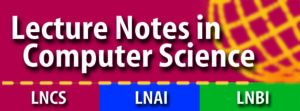|
The ICCBR 2022 Proceedings have just been published as part of the Lecture Notes in Computer Science series (LNAI 13405) , now available online and can be accessed at:
http://link.springer.com/openurl.asp?genre=issue&issn=0302-9743&volume=13405.

List of Accepted Papers
- Fengrui Liu, Yang Wang, Zhenyu Li, Rui Ren, Hongtao Guan, Xian Yu, Xiaofan Chen and Gaogang Xie. (2022). MicroCBR: Case-based Reasoning on Spatio-temporal Fault Knowledge Graph for Microservices Troubleshooting.
|
- Thomas Gabel and Fabian Sommer. (2022). Case-Based Learning and Reasoning Using Layered Boundary Multigraphs.
|
- Barry Smyth and Mark T. Keane (2022). A Few Good Counterfactuals: Generating Interpretable, Plausible and Diverse Counterfactual Explanations.
|
- William Blanzeisky, Barry Smyth and Padraig Cunningham (2022). Algorithmic Bias and Fairness in Case-Based Reasoning.
|
- Richard Noll, Jannik Schaaf and Holger Storf (2022). The Use of Computer-Assisted Case-Based Reasoning to Support Clinical Decision-Making: A Scoping Review.
|
- Mathieu d’Aquin, Emmanuel Nauer and Jean Lieber (2022). A Factorial Study of Neural Network Learning from Differences for Regression.
|
|
|
- Eoin Delaney, Derek Greene, Laurence Shalloo, Michael Lynch and Mark T. Keane (2022). Forecasting for Sustainable Dairy Produce: Enhanced Long-Term, Milk-Supply Forecasting Using k-NN for Data Augmentation, with Prefactual Explanations for XAI
|
- Maximilian Hoffmann, Lukas Malburg, Nico Bach and Ralph Bergmann (2022). GPU-Based Graph Matching for Accelerating Similarity Assessment in Process-Oriented Case-Based Reasoning.
|
|
|
- Katharina Landeis, Gerhard Pews and Mirjam Minor. (2022). Particle Swarm Optimization in Small Case Bases for Software Effort Estimation.
|
- Jonas Nüßlein, Steffen Illium, Robert Müller, Thomas Gabor and Claudia Linnhoff-Popien. (2022). Case-Based Inverse Reinforcement Learning Using Temporal Coherence.
|
- Ciara Feely, Brian Caulfield, Aonghus Lawlor and Barry Smyth. (2022). An Extended Case-Based Reasoning Approach to Race-Time Prediction in Recreational Marathon Runners.
|
- Justine Duck, Romain Schaller, Frédéric Auber, Yann Chaussy, Julien Henriet, Jean Lieber, Emmanuel Nauer and Henri Prade (2022). Analogy-based post-treatment of CNN Image Segmentations.
|
|
|
- Greta Warren, Barry Smyth and Mark T. Keane. (2022). “Better” Counterfactuals, Ones People Can Understand: Psychologically-Plausible Case-Based Counterfactuals Using Categorical Features for Explainable AI (XAI).
|
- Fadi Badra, Marie-Jeanne Lesot, Aman Barakat and Christophe Marsala. (2022). Theoretical and Experimental Study of a Complexity Measure for Analogical Transfer.
|
- Anjana Wijekoon, Nirmalie Wiratunga, Ikechukwu Nkisi-Orji, Chamath Palihawadana, David Corsar and Kyle Martin (2022). How Close is Too Close? Role of Feature Attributions in Discovering Counterfactual Explanations.
|
- Jesus Darias, Juan A. Recio-Garcia, Belen Diaz-Agudo and Marta Caro-Martinez. (2022). Reusing Experiences of Model Agnostic Explanations.
|
|
|
- Adwait Parsodkar, Deepak P and Sutanu Chakraborti (2022). Never Judge a Case by Its (Unreliable) Neighbors: Estimating Case Reliability for CBR.
|
|
|
- David Leake, Zachary Wilkerson and David Crandall (2022). Extracting Case Indices from Convolutional Neural Networks: A Comparative Study.
|
- Fakhri Abbas, Nadia Najjar and David Wilson (2022). Exploring the Effect of Recipe Representation on Critique-based Conversational Recommendation
|
|
|
- Ikechukwu Nkisi-Orji, Chamath Palihawadana, Nirmalie Wiratunga, David Corsar and Anjana Wijekoon (2022). Adapting Semantic Similarity Methods for Case-Based Reasoning in the Cloud.
|


